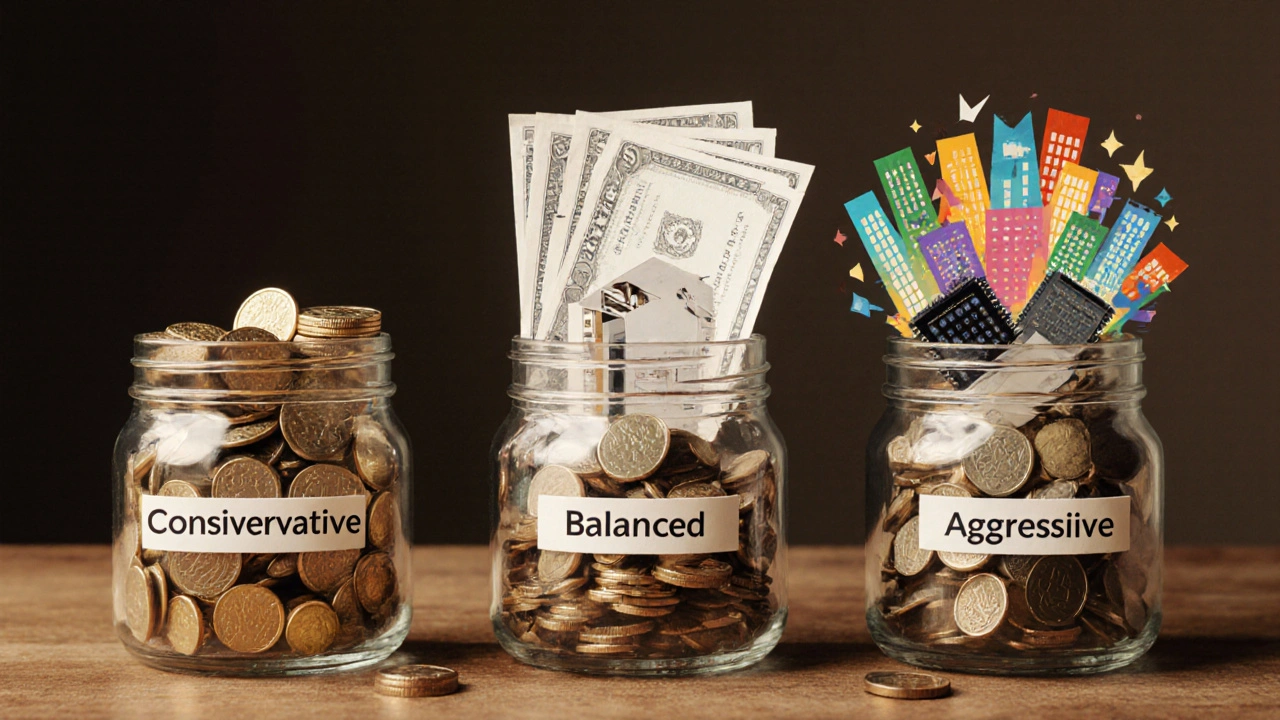Asset Allocation Calculator
Your Investment Profile
Answer a few quick questions to determine your ideal asset allocation.
Your Allocation
Based on your profile, your optimal allocation would be:
Your portfolio should consist of:
0%
Stocks (growth potential)
0%
Bonds (stability)
0%
Cash (liquidity)
Key Takeaways
- Start with a clear picture of your risk tolerance and time horizon.
- Build a diversified portfolio using a sensible asset allocation.
- Take advantage of tax‑advantaged accounts and low‑cost index funds.
- Automate contributions, review performance quarterly, and rebalance when needed.
- Avoid common pitfalls like market timing and chasing hot stocks.
Investments are assets you allocate money to with the expectation of earning a return over time. Whether you’re saving for retirement, a home, or a college fund, the right approach can turn modest contributions into a comfortable future.
Many people think they need a finance degree to grow wealth, but the core principles are simple. This guide walks you through the practical steps to make investments work for you, from assessing your personal situation to choosing the right vehicles and staying on track.
1. Know Where You Stand
Before you buy a single share or fund, answer two questions:
- How much risk can you tolerate?
- How long do you have before you need the money?
Both factors shape your Risk Tolerance and Time Horizon. A young professional with a 30‑year window can afford more volatility than someone nearing retirement.
Use a quick questionnaire - many brokerages offer free tools - to score yourself on a scale from conservative to aggressive. Record the result; you’ll reference it when setting your Asset Allocation.
2. Build a Smart Asset Allocation
An asset allocation is a roadmap that tells you what percentage of your money goes into each major category: stocks, bonds, real estate, cash, etc. It’s the single most powerful decision you’ll make.
Here’s a simple three‑bucket model based on risk level:
- Conservative: 30% stocks, 60% bonds, 10% cash
- Balanced: 55% stocks, 35% bonds, 10% cash
- Aggressive: 80% stocks, 15% bonds, 5% cash
Adjust the percentages to match your own risk score. The goal is to spread risk while keeping enough growth potential to outpace inflation.
3. Diversify Within Each Asset Class
Once you’ve set the high‑level mix, avoid putting all the eggs in one basket. This is where Diversification shines.
For the stock portion, consider a blend of:
- Broad market Index Funds (e.g., S&P 500, total market)
- International equity funds for exposure outside the U.S.
- Sector‑specific funds if you have a strong view on technology or healthcare.
For bonds, mix government, corporate, and high‑yield options to balance safety and yield.
4. Choose the Right Investment Vehicles
Now map each slice of your allocation to concrete products.
| Vehicle | Typical Risk | Typical Return | Liquidity | Best For |
|---|---|---|---|---|
| Index Funds | Medium | 7‑10% annual | High | Core equity exposure |
| Dividend Stocks | Medium‑High | 5‑8% + dividends | Medium | Income‑oriented investors |
| Bonds | Low‑Medium | 2‑4% annual | High | Stability and capital preservation |
| REITs | Medium‑High | 6‑9% annual | Medium | Real‑estate exposure without buying property |
| Robo‑Advisors | Varies by algorithm | Varies | High | Hands‑off, automated rebalancing |
For most beginners, a core of low‑cost index funds plus a small slice of dividend stocks or REITs offers both growth and modest income.
5. Leverage Tax‑Advantaged Accounts
Taxes can eat a large chunk of your returns. Use accounts that shield growth:
- 401(k) / 403(b) - employer‑sponsored, often with matching contributions.
- Traditional IRA - tax‑deductible contributions, tax‑deferred growth.
- Roth IRA - after‑tax contributions, tax‑free withdrawals in retirement.
- Health Savings Account (HSA) - triple‑tax advantage if you have a high‑deductible plan.
Prioritize maxing out any employer match first; it’s essentially free money.

6. Automate Contributions and Stay Disciplined
Consistency beats timing. Set up automatic transfers from your checking account to your investment accounts on payday. This “pay‑yourself‑first” habit builds wealth without you having to think about it.
Many platforms also let you automate purchases of fractional shares, so you can invest even $50 a month.
7. Review, Rebalance, and Adjust
Markets shift, and so will the % composition of your portfolio. Review your holdings at least quarterly:
- Compare current weights to your target allocation.
- If any category is off by more than 5‑10%, sell the over‑weighted assets and buy the under‑weighted ones.
- Re‑assess risk tolerance annually - life changes (marriage, kids, job change) often require a tweak.
Rebalancing can be done manually or delegated to a Robo‑Advisors, which will automatically buy and sell to keep you on track for a low fee.
8. Avoid Common Pitfalls
Even seasoned investors slip up. Keep an eye out for these traps:
- Market timing - trying to buy low and sell high usually backfires. Stay invested.
- Chasing trends - meme stocks, crypto hype, or “hot” sectors can lead to large losses.
- Over‑trading - commissions and spreads add up, eroding returns.
- Ignoring fees - high expense ratios chew returns; stick to <10 basis‑point funds when possible.
9. A Quick Checklist for Ongoing Success
- Set clear financial goals and a timeline.
- Take a risk‑tolerance quiz and define your asset allocation.
- Choose low‑cost, diversified vehicles (index funds, bonds, REITs).
- Open and max out tax‑advantaged accounts.
- Automate monthly contributions.
- Quarterly review and rebalance.
- Adjust allocation when life changes.
Final Thoughts
Making investments work for your future isn’t about finding the next “big thing.” It’s about applying reliable principles consistently: know yourself, diversify wisely, use tax‑efficient tools, automate, and stay disciplined. Follow the steps above, and you’ll watch your money grow from a modest start to a solid nest egg that can fund the life you envision.

How much should I invest each month?
A good rule of thumb is to allocate at least 15% of your gross income toward retirement and long‑term goals. If that’s too much, start with 5‑10% and increase the amount whenever you get a raise or pay off debt.
What's the difference between a traditional IRA and a Roth IRA?
Traditional IRAs let you deduct contributions now and tax the withdrawals later, while Roth IRAs use after‑tax dollars and let you withdraw earnings tax‑free after age 59½, provided the account is at least five years old.
Can I have both a 401(k) and an IRA?
Yes. You can contribute to both, but the total deductible amount may be limited if you or your spouse have a workplace retirement plan and your income exceeds certain thresholds.
How often should I rebalance my portfolio?
Most experts recommend checking quarterly and rebalancing when any asset class drifts more than 5‑10% from its target. Some investors use a calendar‑based approach (e.g., annually) combined with drift thresholds.
Are robo‑advisors worth the fee?
Robo‑advisors typically charge 0.25%‑0.50% of assets annually, which is cheap compared to traditional advisory fees (often 1%+). For simple, diversified portfolios, the convenience and automatic rebalancing often justify the cost.



Meredith Howard
October 22, 2025 AT 01:15Understanding one's risk tolerance is the cornerstone of any investment strategy. It determines how much volatility an investor can endure without abandoning the plan. A clear self‑assessment helps set a realistic asset allocation that aligns with personal goals. While the guide outlines it well I would add that periodic reassessment is essential as life circumstances evolve.
Yashwanth Gouravajjula
November 3, 2025 AT 18:48In India we also value diversified portfolios for future security.
Kevin Hagerty
November 16, 2025 AT 12:22Sure go ahead and chase every hot meme stock its not like you could lose money
Janiss McCamish
November 29, 2025 AT 05:55A three‑bucket model-conservative, balanced, aggressive-covers most risk profiles effectively.